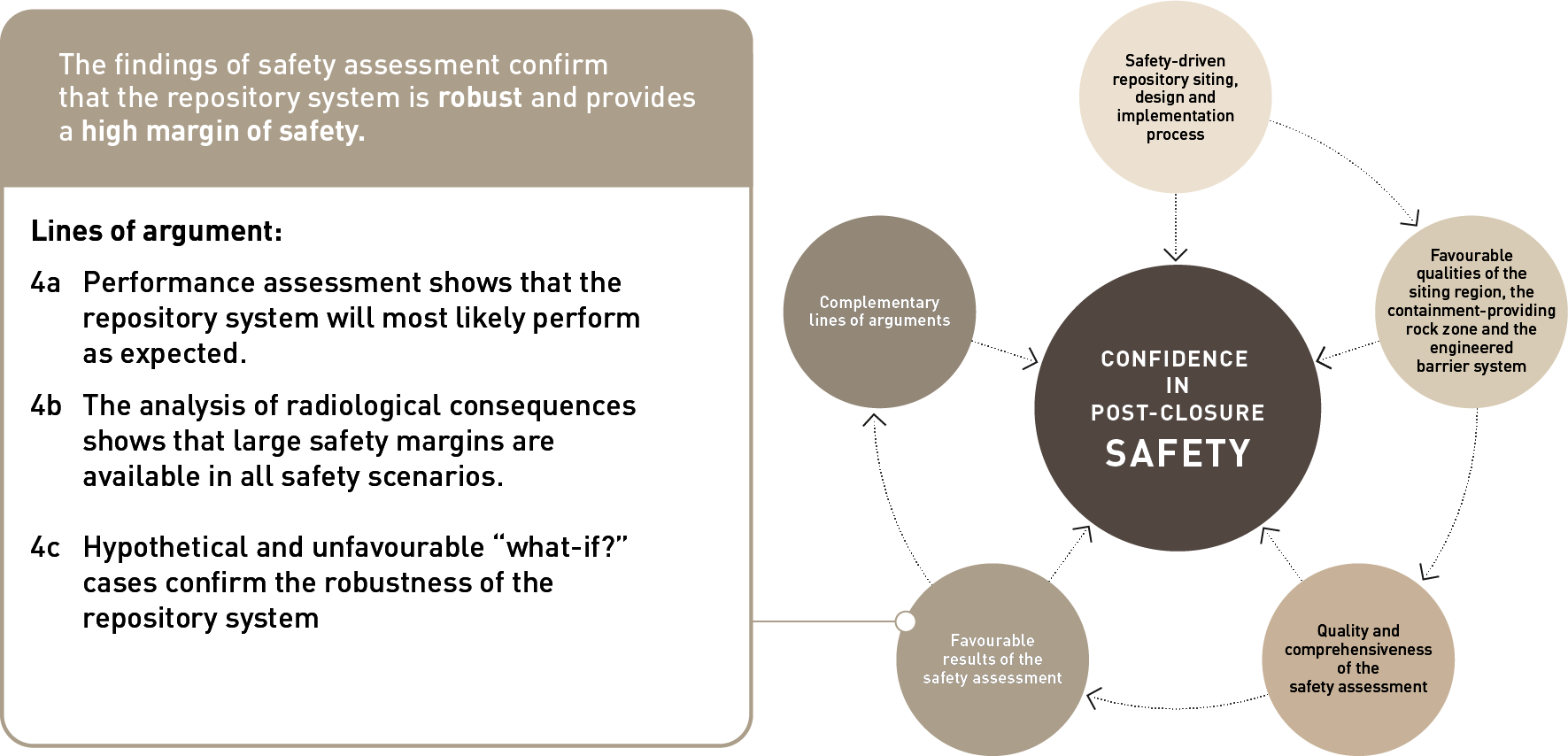Performance assessment analyses the evolution of individual system components and of the entire repository with respect to the various safety functions. The analysis of radiological consequences evaluates annual individual dose or risk for a range of safety scenarios, derived from the results of performance assessment. Since Project Entsorgungsnachweis (Nagra 2002) the body of knowledge has significantly expanded, and the assessment methodologies have evolved. Despite the advances made in the methodologies and tools used to build the safety case over the past 20 years, there is notable consistency in the safety-related findings. This consistency strengthens confidence in the Opalinus Clay as a suitable host rock for radioactive waste.
Specific lines of argument for the claim that the findings of these analyses confirm that the repository system provides a high margin of safety are summarised in Fig. 10‑7 and elaborated in the following paragraphs.

Fig. 10‑7:Lines of argument for the claim that the findings of the safety assessment confirm the high margin of safety provided by the repository system
4a: Performance assessment shows that the repository system will most likely perform as expected
In performance assessment, the expected performance of the multi-barrier systems is expressed in terms of a set of claims concerning the contribution of each component of the multi-barrier system and of the overall repository system to the repository safety functions, in line with the current safety concept. Sound arguments are provided for each claim, which are themselves supported by convincing evidence, such that the claims are deemed robust. Overall, the performance assessment shows that, following a rigorous evaluation of the functioning of the evolving disposal system and considering all identified sources of uncertainty, the system will perform its safety functions and conform to the reference safety scenario in most reasonably foreseeable circumstances. Deviations from the expected performance are captured in other, alternative, safety scenarios.
The performance assessment is synthesised in NTB 24-22 Rev. 1 (Nagra 2024u) and its findings are summarised in Chapter 6 of the present report. The development of safety scenarios, accounting for the results of the performance assessment, is described in Section 4.4 in NTB 24‑21 (Nagra 2024e), and the safety scenarios themselves are summarised in the present report in Chapter 7.
4b: The analysis of radiological consequences shows that large safety margins are available in all safety scenarios
The annual individual effective dose is the main “safety indicator” used in the analysis of radiological consequences. The maximum dose rates are summarised in Fig. 8‑14, where they are compared with both the regulatory guideline of 0.1 mSv/a and with the range of typical radiation exposure in Switzerland.
The coloured horizontal bars indicate individual calculations, e.g., for different variants within each safety scenario. For each of these variants, maximum dose rates are below both the regulatory guideline and the range of typical radiation exposures in Switzerland, often by several orders of magnitude. The figure also shows the results of a probabilistic uncertainty analysis carried out for the reference safety scenario, and the results of deterministic cases where the most sensitive parameters are set to their most pessimistic bounding values. Even in the most pessimistic cases, the maximum dose rate remains below the regulatory guideline, highlighting the robustness of the results with respect to remaining uncertainty.
The regulatory risk criterion has been applied when analysing excavation of the repository by erosive processes for the time period for assessment, i.e., up to one million years post-closure. The annual risk is found to be more than two orders of magnitude below the risk criterion of 10‑5 per year and is so low that any impact during this period may be considered, in effect, hypothetical. Beyond one million years, the calculated dose rate is found to be within the range of natural background radiation exposure in Switzerland, which is again in accordance with the regulatory requirements.
The analysis of radiological consequences is documented in detail in NTB 24-18 (Nagra 2024p). Key aspects and results are presented in Chapter 8 and findings are summarised in Section 8.6 of the present report.
4c: Hypothetical and unfavourable “what-if?” cases confirm the robustness of the repository system
Fig. 8‑14 also shows the maximum dose rates calculated for “what-if?” cases that involve extreme and hypothetical assumptions. These include the occurrence of hypothetical events, as well as the hypothetical degradation of each of the pillars of safety without any specified cause. Even in these cases, the calculated dose rates remain below the regulatory dose criterion, thus confirming the robustness of the repository system.
The analysis of “what-if?” cases is part of the wider analysis of radiological consequences documented in NTB 24‑18 (Nagra 2024p) and is summarised in Chapter 8 of the present report.

